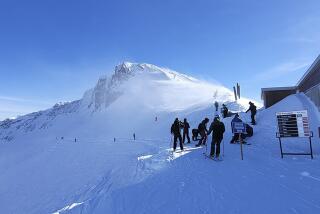Washington avalanche: New safety device saves one skier
Three skiers died Sunday in a Washington avalanche. Another was saved by a new safety device called a flotation air bag -- equipment tucked inside a skier’s backpack, ready for deployment in case of an avalanche.
On Sunday, an avalanche swept four skiers about a quarter of a mile down an out-of-bounds canyon on the back side of Stevens Pass in the Cascade Mountains, about 80 miles northeast of Seattle.
Professional skier Elyse Saugstad was saved by the inflatable safety device, believed to be the second time in recent weeks the portable air bags saved a life. The earlier incident was in Colorado, according to John Snook of the Colorado Avalanche Information Center.
In an interview with the Associated Press, Saugstad credited the air bag with saving her life, saying she’d been buried “except for my head and hands.”
The inflation device works like an air bag or a flotation vest available on aircraft, Snook said. It operates out of a backpack that contains the bag and a compressed air container. The skier triggers the device, usually by pulling on a strap, and the compressed air inflates the bag or bags, which come out of the top of the backpack.
“It’s kind of like a flotation device,” Snook said in an interview Monday with The Times. “The idea is to keep you near the top of the avalanche so there is a greater possibility of being found.”
The key to surviving an avalanche is to stay above the snow. Even being buried just three to six feet down sharply decreases the chance of survival. Being buried for 30 minutes drops the survival rate to just about 50%, while being buried for an hour can drop the rate to between 10% and 20%, Snook said.
There aren’t any good statistics on how the flotation device changes the survival odds, because the device is still relatively new. It has been used in Europe in recent years and there are a number of confirmed saves, Snook said.
Still, the device isn’t a panacea. The device works by keeping the skier near the top of the snow, “but it isn’t going to save you from trauma if you go over a cliff or hit a tree,” Snook said.
“The best way not to die in an avalanche is to stay out of one in the first place,” he said.
The flotation air bag costs between $700 to $1,000 depending on the manufacturer, Snook estimated. Pricey, but a good pair of skis can run about $1,000.
“If it save your life,” Snook said, then the cost “doesn’t seem like that much.”
ALSO:
IRS reveals its ‘dirty dozen’ tax frauds
A poignant, spiritual funeral service for Whitney Houston
Favorite ‘son’: Bruce Springsteen and the National Constitution Center
More to Read
Sign up for Essential California
The most important California stories and recommendations in your inbox every morning.
You may occasionally receive promotional content from the Los Angeles Times.










